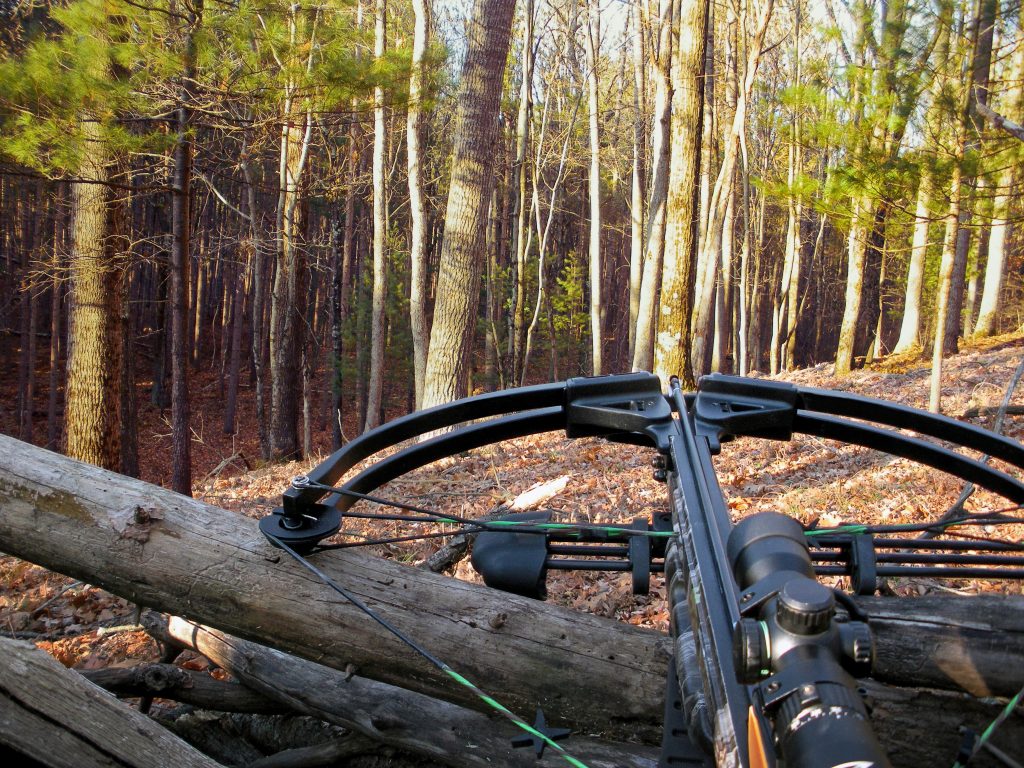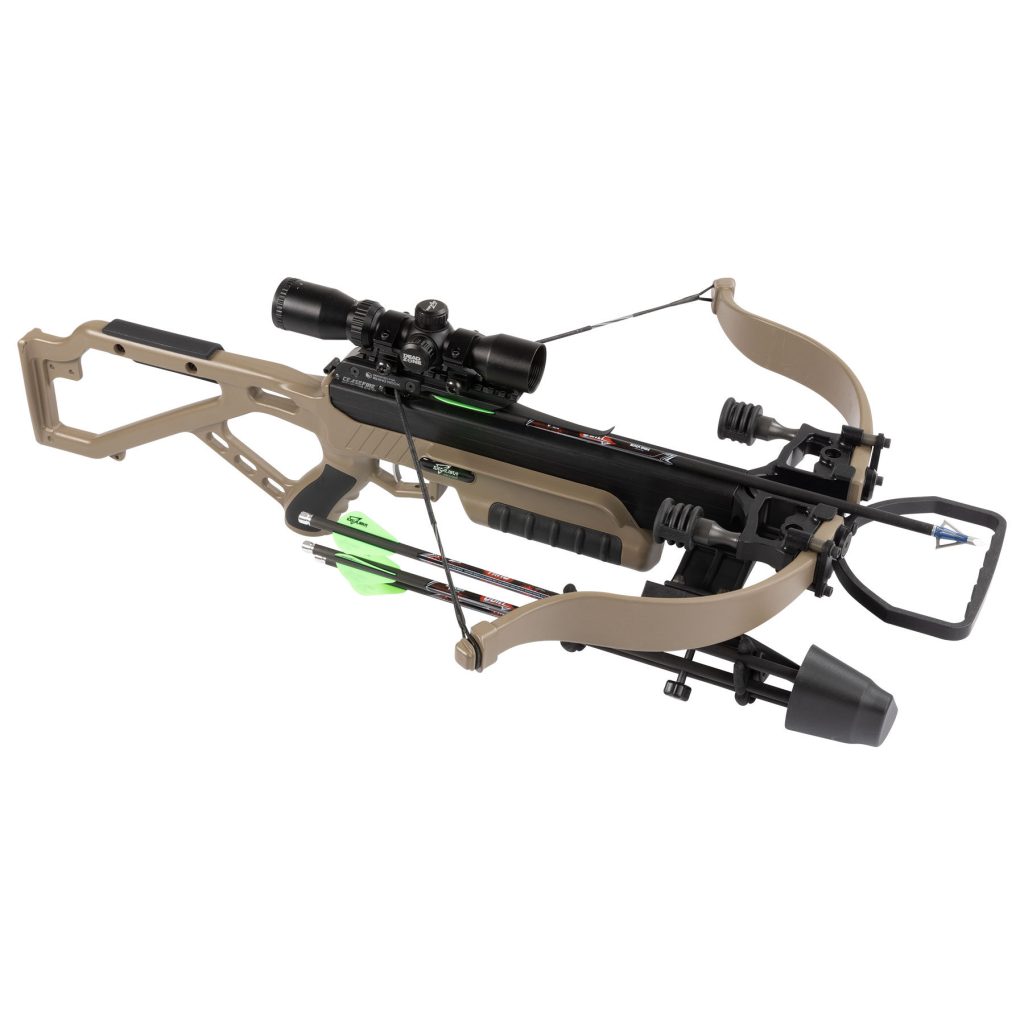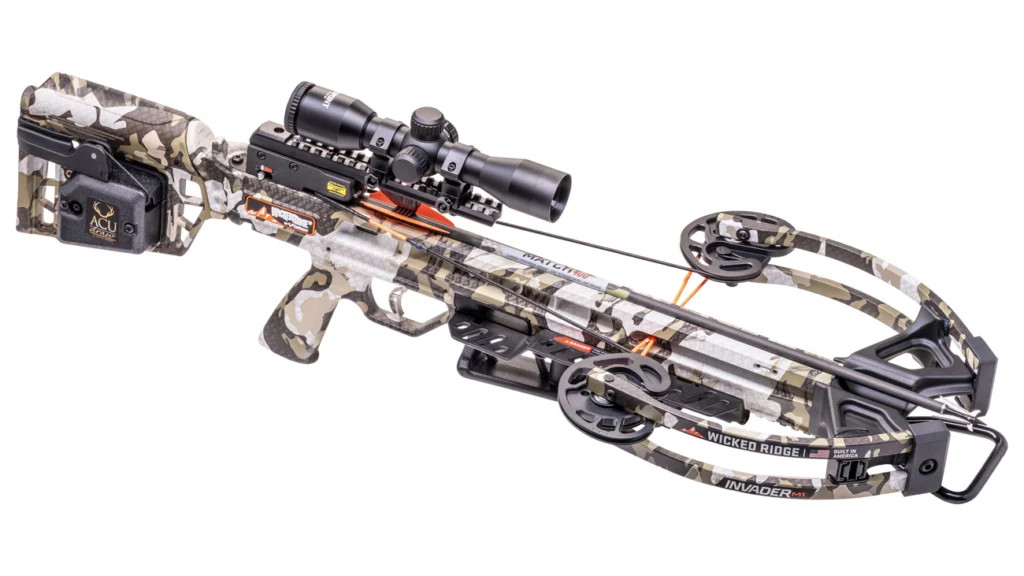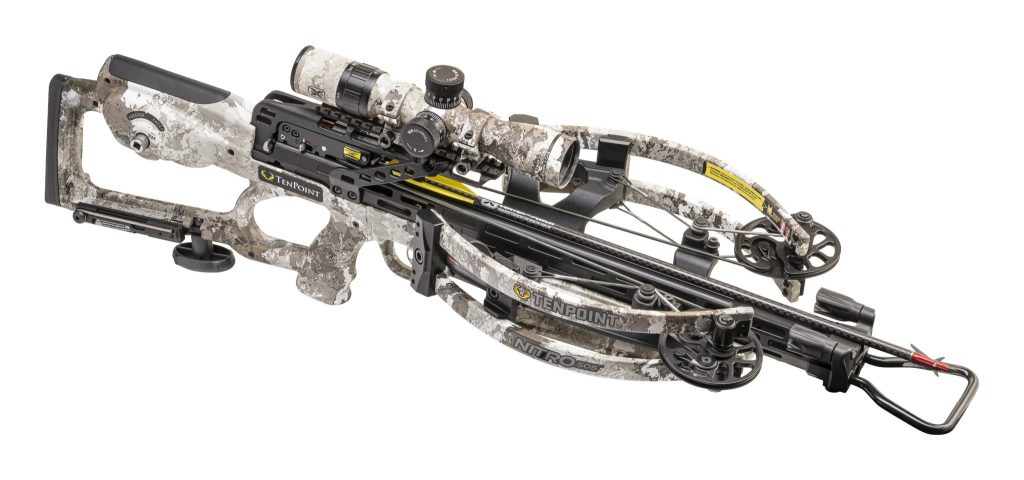As somebody who predominantly hunts public land, juggles both a job and a kid, and who enjoys doing a variety of other outdoor activities aside from deer hunting, crossbows are the bee’s-knees. It’s far easier to stay lethal with one when you have a busy schedule and would rather fish than fling arrows on a summer’s day. They also make it much easier to effectively hunt from the ground, allowing you to be truly mobile. And in a world where it’s increasingly necessary to restrict gun hunting opportunities due to urbanization, the best crossbow allows me to hunt on tracts and during dates where I otherwise wouldn’t be able to.
I’ve managed to put my hands on a lot of crossbows over the years thanks to my experience managing an archery counter. I’ve watched crossbow designs become markedly better as they were popularized, and I can say with confidence that there’s never been a better time to buy a crossbow. In this article, we’ll go over what I think are some of the best designs out there currently, and discuss criteria I use to evaluate crossbows for deer hunting.
Understanding Crossbow Specifications
Before we go too far discussing crossbows, it’s important to understand some important specifications that are commonly listed and that help us to evaluate a crossbow’s performance and suitability for hunting.
Draw Weight
Crossbow draw weight is a critical factor to consider when choosing a crossbow for hunting, as it directly impacts the crossbow’s suitability for different types of game and its usability. Draw weight refers to the force required to cock or draw the crossbow string back to its firing position. It is typically measured in pounds (lbs).
The draw weight of a crossbow determines how much energy is stored in the limbs and transferred to the arrow upon release. A higher draw weight results in greater arrow speed and kinetic energy, which are crucial for achieving an effective and humane kill when hunting. The faster the arrow, the better it can penetrate the target, especially for larger game animals.
Draw weight is particularly important for hunters who may need to take shots at longer ranges or need to penetrate thick hide or bone. A higher draw weight crossbow ensures that the arrow maintains its trajectory and penetrative power over longer distances.
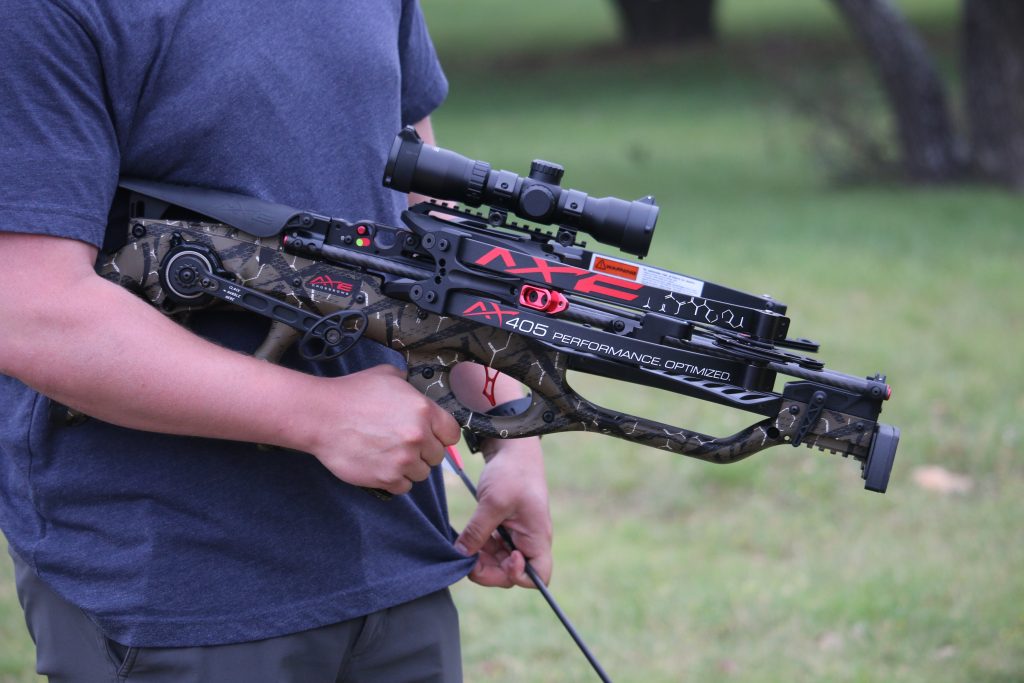
However, it’s important to strike a balance between draw weight and the physical capabilities of the hunter. A crossbow with a draw weight that is too high for the shooter can lead to accuracy issues and increased fatigue. Hunters should choose a draw weight that they can comfortably handle and consistently shoot accurately.
A final factor to consider when analyzing a crossbow’s draw weight is that most states have specific regulations regarding minimum draw weight requirements for hunting certain types of game. It’s crucial to be aware of these regulations and ensure that your chosen crossbow meets or exceeds the legal requirements in your area.
In general, you want as much draw weight as you can comfortably handle.
Axle-To-Axle Length
Crossbow axle-to-axle length, often abbreviated as A2A length, is a crucial specification to consider when choosing a hunting crossbow. It refers to the distance between the two axles or cam hubs located at each end of the crossbow’s limbs.
The A2A length directly affects the overall size and maneuverability of the crossbow. A shorter A2A length results in a more compact and maneuverable crossbow, making it easier to navigate through dense vegetation, tight hunting blinds, or when stalking game in the field. This is especially advantageous when hunting in close quarters or wooded areas.
A shorter A2A length also generally leads to a lighter and more balanced crossbow. This makes it easier to carry and aim, reducing fatigue during extended hunting sessions. Hunters may need to carry their crossbows for extended periods, so a more manageable size can be a significant advantage.
A lighter, more maneuverable crossbow provides a huge advantage for hunters. The shorter the A2A length, the easier it is to shoot the bow without having to worry about the limbs inadvertently coming into contact with a blind, stand, limb, or tree trunk. Lighter, more maneuverable bows are also much more pleasant to carry through the woods.
Power Stroke
Power stroke refers to the length of the bowstring’s travel from its fully cocked position to the rest position when fired. The power stroke is second only to the draw weight of a bow in determining a crossbow’s potential energy transfer to a bolt. A longer power stroke allows the limbs to store and release more energy into the arrow, resulting in increased speed and penetration.
The drawback of a longer power stroke is that it often makes the bow physically longer and more cumbersome. However, in this article we’ll discuss several bows that cleverly “hide” a long power stroke in a relatively short body.
Types Of Crossbow Designs
There are several common crossbow designs, each with their own pros and cons.
Recurve Crossbows
Recurve crossbows have a straightforward, traditional design. A recurve crossbow’s limbs simply bend to store energy, and release it when they straighten. This design is favored for its simplicity and durability, as it has fewer moving parts than more modern compound crossbows. However, they usually generate lower arrow speeds compared to compound crossbows, requiring a higher draw weight for adequate speed and penetration.
Compound Crossbows
Compound crossbows utilize a system of pulleys and cables that provide mechanical advantage when drawing the string. This design allows for higher draw weights and increased arrow speeds, making compound crossbows effective for longer-range shots. They are often more compact and narrow, enhancing maneuverability in tight hunting spaces. However, the added complexity of the pulley system can result in increased maintenance requirements, and they can be noisier due to the additional moving parts.
Reverse Limb Crossbows
Reverse limb crossbows have gained popularity for their unique design, where the limbs curve forward when uncocked and then curve backward when cocked. This design often results in a more compact and balanced crossbow. The enhanced balance and weight distribution make them comfortable to shoot, and they also manage to pack a longer A2A length into a physically smaller bow.
Vertical Limb Crossbows
Vertical limb crossbows have limbs that are aligned with a vertical axis as opposed to horizontal. Basically, imagine rotating the limbs on a “normal” crossbow by 90 degrees.
This unique design offers a more compact profile, making them easier to carry than other designs. However, they have limited availability in comparison to other designs, and while they maintain decent arrow speeds, they don’t typically match the speeds of conventional compound crossbows. That said, the unique design is in my opinion the best we currently have on the market.
Choosing The Appropriate Crossbow Accessories
When you buy a crossbow, they typically come with a few important accessories. The quality (or lack thereof) of the optic that they come with in particular impacts the value of the bow, but how many and what kind of bolts, cocking aids, and noise dampening features they include should also be considered in your analysis. Accessories come second in consideration, behind features such as limb orientation, draw strength, and A2A length, but they’re still important variables that may shift your selection from one similar model to another.
Optics(Scopes And Red Dot Sights)
A good crossbow is useless without a good scope. You can’t shoot what you can’t see, and a cheap scope will eventually leave you in a frustrating position where you can see the deer with your naked eye, but not through the scope when you shoulder your weapon. Several criteria can help you determine what makes a good crossbow scope:
Magnification: Crossbow optics typically have fixed magnification, commonly ranging from 1x to 5x. The choice depends on your shooting preferences and the type of game you hunt. Lower magnification (1x or 2x) provides a wider field of view for close-range shots, while higher magnification (3x to 5x) is better for longer-range accuracy. Anything above that magnification level is of dubious usability.
Objective Lens Size: While many hunters get hung up on magnification, objective lens diameter is a much more important metric to consider. The objective lens diameter affects the amount of light the optic gathers. A larger objective lens allows more light to enter, improving low-light performance and image clarity. This is important since most game activity takes place right at first and last light and in thick cover. A larger objective lens also gives you a wider field of view, which is important when you’re trying to find a moving target in your scope. When in doubt,
Reticle Type: Reticle type isn’t as crucial as magnification and objective lens diameter, but it’s still important. Rifle hunters buying a crossbow for the first time often want a precision reticle. This is a mistake. A crossbow is a short range weapon. Fast target acquisition is the name of the game. You want a clean, crisp, simple reticle.
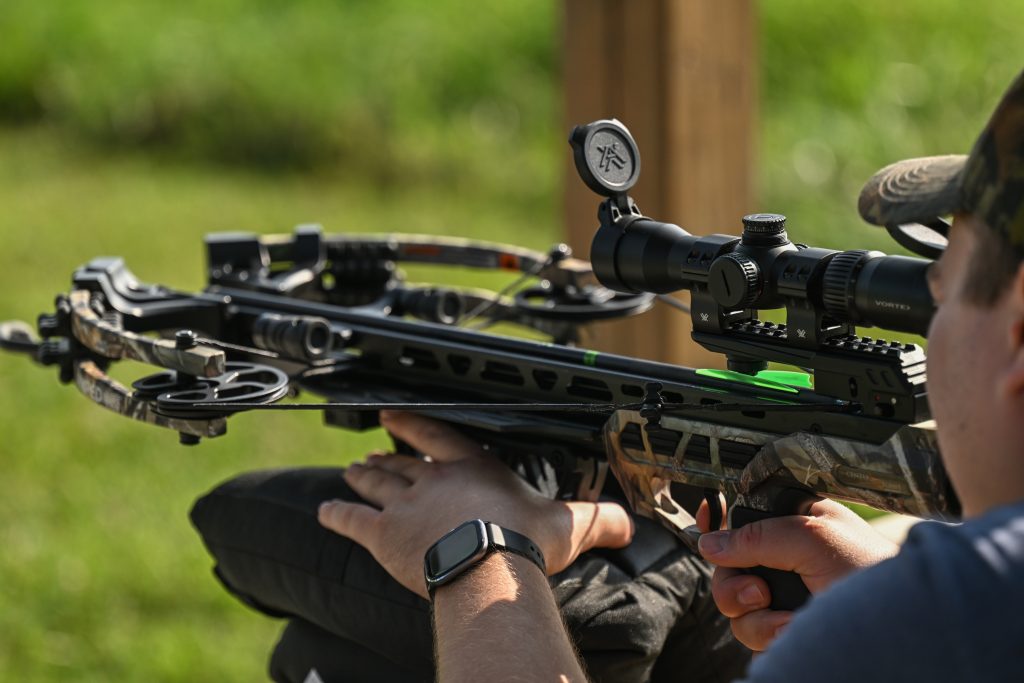
Illumination and Brightness Control: If your crossbow optic features an illuminated reticle, ensure it has multiple brightness settings. This allows you to adapt to changing light conditions and maintain visibility of the reticle against various backgrounds. Counterintuitively, how bright a lighted reticle is isn’t nearly as important as how dim you can make it. In low-light conditions, a too-bright reticle can “wash out” the target behind it, making it impossible to get a shot off.
Durability and Weather Resistance: Look for optics with rugged construction, waterproofing, and fog-proofing to withstand harsh weather conditions. “Nitrogen purged” is a good keyword to look for when evaluating scopes. Shock-resistant optics can endure recoil without losing zero. While we’re on the topic, always carry a spare battery for any illuminated reticle or red-dot sights.
Clarity and Image Quality: A high-quality lens coating and glass are crucial for clarity and light transmission. Multi-coated or fully multi-coated lenses reduce glare, enhance image brightness, and provide sharpness. This is often what separates mediocre optics from quality ones, since good prisms and glass are expensive to manufacture.
Compactness and Weight: Consider the overall size and weight of the optic. For hunting purposes, a compact, lightweight optic is easier to carry and maneuver in the field.
Ease of Zeroing: Look for optics that are easy to zero and hold their zero over time. The knobs used to change zero should be easy to manipulate, and more importantly “click” sharply when turned. If a scope’s adjustment knobs are “mushy” instead of crisp, be suspicious of that optic’s quality.
In summary, a good crossbow optic should provide clear and bright optics, be rugged and weather-resistant, have an appropriate reticle for your needs, offer multiple brightness settings, and be easy to mount and zero. Many crossbow manufacturers package their bows with very low-quality optics that cost them as little as possible. More expensive models may become relatively less expensive when you factor in the cost of replacing the scope that came with the bow with a better piece of glass.
Bolts
Almost all crossbows will come with at least 2-3 bolts. What’s more important than how many bolts a crossbow comes with is whether or not those bolts are proprietary to that bow. Many manufacturers insist that you use only their bolt with their bow or risk damaging the bow or at least voiding any warranty. This can come as a surprise to a hunter used to conventional compound bows, which can shoot arrows from any manufacturer.
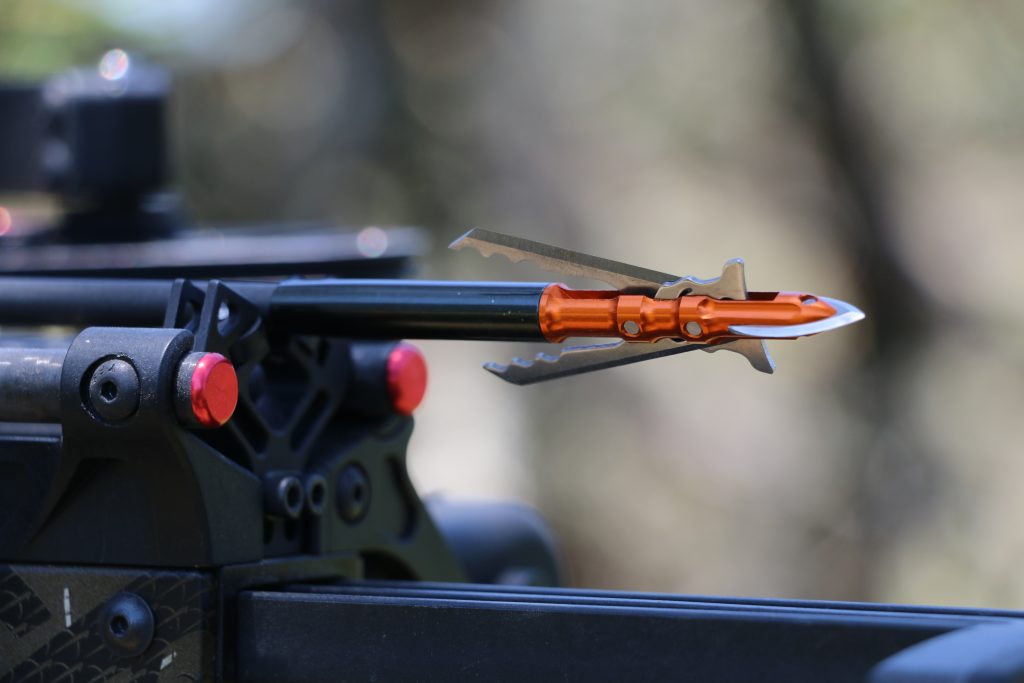
If the crossbow you’re considering recommends or necessitates a proprietary bolt, the question becomes how expensive are those bolts and how readily available are they? Prices vary significantly across brands, and it can be immensely frustrating to not be able to quickly find the bolts you need, particularly if you run out during the season or while out-of-state.
Cocking Devices
Most crossbows require over 100 lbs of force to cock. Some require over 150 lbs. This re quires a substantial amount of physical exertion for most hunters. Many crossbow manufacturers offer cocking aids to reduce the amount of effort required to arm the bow. They range from simple “rope cockers” that are just 2:1 ratio pulleys with handles to crank driven, ratcheting mechanisms permanently mounted to the crossbow.
It’s important to know whether or not your chosen manufacturer offers a cocking aid, and if so whether or not one is included with your purchase or if you’ll be expected to purchase this separately. Many bows, particularly those with very narrow A2A lengths or with reverse or vertical limb designs, cannot be cocked by simply pulling the string back with your hands.
Noise Dampening And Vibration reduction
Crossbows pack a tremendous amount of energy into a very small frame. They also have a fair amount of moving parts. Combined, this can equal a lot of vibration and noise. Limb, string, and stock dampeners can absorb that excess energy and noise and make for a quieter bow that is more pleasant to shoot.
Best Recurve-Limb Crossbow
Excalibur Micro Extreme Crossbow Package
Features
- Up to 360 FPS velocity
- Ultra-compact and lightweight
- High-Output Express limbs deliver devastating power
- CeaseFire anti dry-fire system prevents the bow from being fired without a loaded bolt
- Match-grade trigger puts you in total control
- Ambidextrous cheek piece attaches quickly to maximize comfort and crossbow control
- R.E.D.S. Suppressors substantially reduce shock, vibration, and noise
- 21″ axle-to-axle cocked, 25″ uncocked
- Dead Zone speed-rated Scope included
The Micro Extreme from Excalibur is the epitome of convenience and safety in the world of crossbows. Its ultra-compact, lightweight design guarantees maneuverability and comfort in any hunting scenario. With the CeaseFire anti dry-fire system, you can trust that your crossbow won’t fire unless an arrow is loaded, the safety is off, and the trigger is pulled. Excalibur’s legendary craftsmanship ensures it’s the most rugged and reliable crossbow in its class. Featuring a best-in-class trigger system that emulates the performance of top-tier match-grade rifle triggers, the Micro Extreme also boasts Micro High-Output Express Limbs for enhanced durability and performance. To top it off, the inclusion of R.E.D.S. Suppressors significantly reduces shock, vibration, and noise. With a limited lifetime warranty, this crossbow is the ultimate combination of safety, reliability, and performance.
Best Compound Crossbow
Wicked Ridge XBOW Invader M1
Features
- Built-In ACUdraw: Best-in-class crank cocking device reduces draw weight to just 5 lbs. for easy & effortless cocking.
- Lightweight 5.8-pounds and Compact Profile: More mobility and more shot opportunities by reducing the chance for cam/limb contact in the stand or blind.
- NEW 70-yard Pro-View 400 Scope: Offers aimpoints out to 70-yards and features an updated reticle for a cleaner view and greater down-range accuracy.
- Pre-Sighted at 20-yards: Pre-sighted by American workers before leaving the factory to ensure your success.
- Built in America: Inspected, built, and tested by American workers to guarantee craftsmanship you can depend on.
The Invader M1 crossbow is a lightweight powerhouse, weighing just 5.8 lbs and measuring 9.5” narrow. It boasts a top speed of 390 FPS and features a built-in ACUdraw Cocking Device for easy cocking, along with a lighted Pro-View 400 scope for enhanced accuracy. Made in America, it offers reliable craftsmanship. The integrated cocking device ensures you’re always ready to shoot without needing an extra rope.
Best Reverse-Limb Crossbow
TenPoint Nitro 505
Features
- TenPoint’s fastest, most powerful crossbow ever
- 505 fps with 227 ft. lbs. of energy
- Newly designed RX-8 Cam System – rotate 404° to help create a huge 17″ power stroke
- Easy to maneuver – just 6.5″ from axle to axle when cocked
- Reverse draw design – balances better, easier to hold steady
- Deeper cam grooves accommodate stronger string and cables
- Advanced S1 Trigger – 2-stage, zero-creep design delivers 3.5-lb. pull and greater trigger control
- Integrated ACUslide cocking and decocking system – just 5 lbs. of force
- EVO-X Marksman Elite Scope – variable speed scope built for long-distanced performance
- Draw Weight: 300 lbs
- Overall Length: 30.5″
- Weight: 7.9 lbs.
Designed for speed-seeking hunters, this state-of-the-art reverse-draw crossbow seamlessly combines balance, power, and downrange precision. Its user-friendly cocking and de-cocking system make it easy to handle. This crossbow achieves a remarkable 505 fps speed, delivering 227 ft. lbs. of energy with a compact 6.5″ axle-to-axle width when cocked. The RX-8 Cam System offers a 404° rotation and a 17″ power stroke, enhancing speed while minimizing draw weight for a smoother, quieter shot. The system features deep cable grooves and improved spacing for a strong, durable string and cables. Its 2-stage S1 Trigger provides a consistent 3.5-lb. pull for precise shooting. The integrated ACUslide system makes cocking and decocking effortless with just 5 lbs. of force and includes safety features. Plus, it includes an EVO-X Marksman Elite Variable Speed Scope for exceptional distance accuracy.
Best Vertical Limb Crossbow
Mini In-Line Vertical Crossbow
Features
- Rear trigger housing with sear pin, linkage block, linkage stop, and linkage rod
- Cheek plate, shoulder stock, anti dry-fire and gold string latch
- Front trigger housing with grip gold trigger, safety tab and thumb position grove
- Front linkage block, trigger guard, and trigger pull spring
- Quad limb setup to eliminate excessive limb twist
- Scope rail adjustments for left and right arrow POI
- 3 bristled arrow rest centered flush with the borders
The Mini In-Line Vertical Crossbow sets itself apart with its unique vertical design, offering exceptional balance and ease of use for accurate freehand shooting. It suits individuals of all heights, serving as a versatile, one-size-fits-all solution. The adjustable poundage feature is particularly attractive to children and women, allowing customization of draw weight for various shooting needs. This compact, lightweight bow (29″ length, 6 lbs weight) delivers impressive speeds (325-330 fps) with a 23-inch, 380-grain arrow. Disarming the bow is simple and doesn’t require shooting or special equipment. Its vertical design enables convenient propping against a tree for shooting, a unique advantage. Maintenance is hassle-free, with no need for a press when changing strings or cables, and it’s compatible with standard arrows.
Final Thoughts On Choosing The Best Crossbows
In conclusion, selecting the best crossbow is a decision that requires careful consideration of various factors, all aimed at aligning the weapon with your specific needs and preferences. As we’ve explored throughout this article, factors such as draw weight, speed, accuracy, and safety features play pivotal roles in determining the ideal crossbow for your hunting or target shooting adventures.
In your quest for the best crossbow, be sure to test out different models, read reviews, and seek advice from experienced hunters and archers. Ultimately, the best crossbow for you will be the one that feels like an extension of yourself, enabling you to pursue your outdoor adventures with confidence and precision.
Full Disclosure: This post may include affiliate links. There’s no extra charge to our readers for using these.

